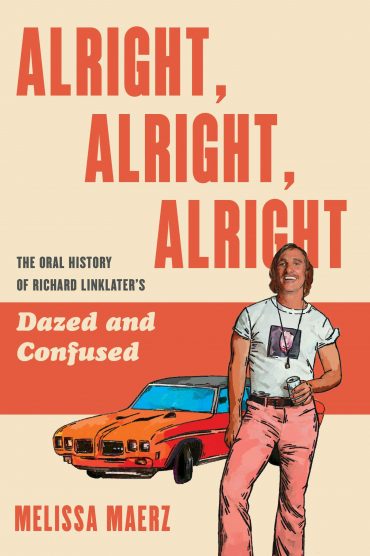 By MELISSA MAERZ (HarperCollins; 2020)
By MELISSA MAERZ (HarperCollins; 2020)
Richard Linklater’s DAZED AND CONFUSED (1993) is one of the great films of the nineties. Depicting what occurs on the night of the last day of an Austin, TX high school in 1976, it’s a vast, unruly party of a movie that also happens to be an unusually thoughtful and observant portrait of adolescence with nary a trace of nostalgia; as one of the film’s signature lines of dialogue states, “if I ever start referring to these as the best years of my life, remind me to kill myself.”
This indispensable oral history of the film, written by Rolling Stone reporter Melissa Maerz, takes us through its conception, which Linklater shaped in a manner similar to his no-budget triumph SLACKER (1990). The primary inspiration was Linklater’s own teenage memories; that includes the notorious hazing scenes in which cast members are paddled and sprayed with condiments, which seemed gratuitous to many viewers (myself included), but which Linklater insists were, like everything else in the film, based on fact.
He also managed to secure the backing of Universal, resulting in a staunchly personal, quirky film made with big studio resources, and a cast of unknowns that included future names like Matthew McConoughey, Ben Affleck, Rene Zellweger and Parker Posey. That achievement didn’t come about without a great deal of struggle by Linklater, who had to fight clueless studio heads at every turn, and published a famously acerbic tract about the experience in the Austin Chronicle (reproduced here).
Dazed and Confused Trailer
The exploits of Linklater’s young cast, as you might guess, were decidedly less fraught. According to their own recollections, drinking, pot smoking and hooking up were the order of the day—meaning the experience of making the film wasn’t much different from what occurred onscreen.

Also provided are answers to many of the questions I have about DAZED AND CONFUSED. I’ve long wondered why is was that Milla Jovovich is prominently featured in the poster art and end credits yet barely figures in the film itself (answer: because she hooked up with co-star Shawn Andrews, whose onset behavior resulted in both actors getting theirs parts severely reduced), and why McConoughey’s character, a twentyish loser who hangs out with high schoolers to get laid, somehow ends up canoodling with the football players in a climactic scene (Shawn Andrews was apparently supposed to be there but got let go early, and so McConoughey took his place), and why it took several years for a proper soundtrack album to be released (because Universal had very little faith in the film, and even less in the soundtrack).
Maerz also deserves credit for exploring what occurred in the years after the film’s release. Its cast and crew can be forgiven for mistakenly believing DAZED heralded a new wave in American filmmaking (I thought the same thing), when in truth it was a product of a very specific era whose likes we probably won’t be seeing again. Disillusionment set in as DAZED’s participants learned that Linklater’s focused and inclusive directing style was not the norm in Hollywood, and that the seemingly unbreakable bond formed during the film’s production was destined to be short lived (as actor Jason London says of a reunion party, “It didn’t feel like family anymore”).
Linklater has described DAZED as an “anti-nostalgia” movie, a statement that’s picked over at some length in these pages. As actor Rory Cochrane asserts, “it’s a complete nostalgia movie,” although the nostalgia it evokes is not for the 1970s, but rather the time in which DAZED was made. Anyone doubting that the early 1990s were a golden age for cinema need only view DAZED AND CONFUSED or read this book—or, better yet, do both.
